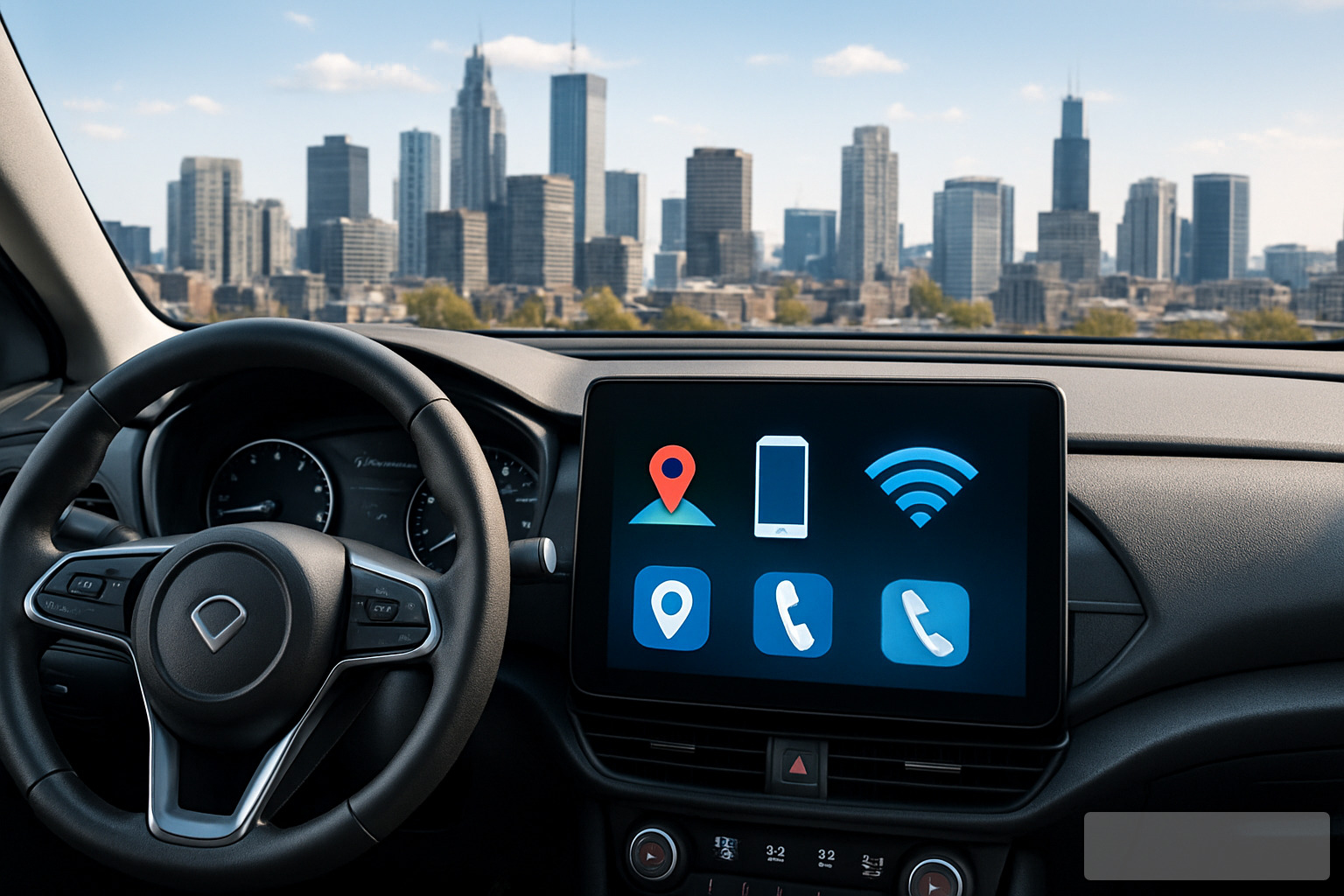Automotive connectivity solutions: 7 Powerful Benefits in 2025
The Connectivity Revolution in Vehicles
Remember when cars were just… cars? Those days are rapidly fading in the rearview mirror. Today’s vehicles are becoming rolling smartphones, thanks to the magic of automotive connectivity solutions that transform our driving experience in ways we could only dream of a decade ago.
What Are Automotive Connectivity Solutions?
At their heart, automotive connectivity solutions are the technologies that let your car talk – to other vehicles, to traffic lights, to the internet, and even back to the manufacturer. It’s like giving your car a voice and ears, allowing it to become an active participant in the digital world around it.
The building blocks of this connectivity revolution are fascinating. Telematics systems silently collect and transmit data about your vehicle’s health and location, allowing for everything from stolen vehicle recovery to predictive maintenance alerts that can save you from being stranded. Vehicle-to-Everything (V2X) technology lets cars communicate with nearby vehicles and infrastructure – imagine getting a warning that the car ahead of you just slammed on its brakes, even before you can see its brake lights.
Your car’s cellular connectivity has evolved from basic 3G to lightning-fast 5G networks, enabling smooth streaming for passengers and critical over-the-air updates for the vehicle itself. And those updates are becoming increasingly important, as modern connected cars can contain up to 150 million lines of software code – that’s more than some commercial airliners!
The silent hero enabling global connectivity is eSIM technology, which allows your vehicle to connect to local networks worldwide without physical SIM card swapping. Meanwhile, sophisticated cloud-based software platforms manage everything from your personalized comfort settings to advanced driver assistance features.
By 2030, this won’t be just for luxury vehicles – industry projections show approximately 95% of new vehicles sold globally will be connected, up from around half today. The global Connected Car market is on track to reach a staggering $225 billion by 2027, making it one of the automotive industry’s most explosive growth areas.
“The promise of a fully connected car inspires drivers, automakers and automotive service providers alike,” notes industry experts at Thales, with over two decades of experience connecting vehicles across more than 450 mobile operators worldwide.
For us drivers, connectivity delivers real benefits we can feel: automatic emergency calls after accidents, maintenance alerts before breakdowns happen, navigation that knows about the traffic jam ahead, and seamless integration with our digital lives. For manufacturers, it creates new revenue streams through subscription services, with consumers willing to pay up to €55 monthly for premium connected features.

As we accelerate toward this connected future, the line between “car” and “tech device” continues to blur. That family SUV in your driveway isn’t just transportation anymore – it’s a sophisticated computing platform that happens to have wheels. And honestly? The ride’s never been more interesting.
Automotive Connectivity Solutions Explained
At their core, automotive connectivity solutions are the technologies, hardware, and software that allow vehicles to communicate with the outside world and process information to improve driving, safety, and entertainment. Think of them as the digital nervous system that transforms regular cars into smart, responsive machines that interact with their environment.
Modern connected vehicles don’t just talk to themselves – they’re part of a much larger conversation. Your car might be communicating with other vehicles about traffic conditions, checking in with traffic lights to optimize your route, or sending diagnostic information to the manufacturer’s cloud servers. This web of connections creates a safer, more efficient driving experience.
When we talk about vehicle communication, we’re really talking about several different types of connections. Your car might use V2V (Vehicle-to-Vehicle) technology to warn nearby cars about sudden braking, V2I (Vehicle-to-Infrastructure) to interact with smart traffic signals, V2N (Vehicle-to-Network) to stream your favorite music, V2P (Vehicle-to-Pedestrian) to detect someone crossing the street, or even V2G (Vehicle-to-Grid) if you drive an electric vehicle that can send power back to the electrical grid.
Together, these communication modes create what industry experts call V2X (Vehicle-to-Everything) technology – a comprehensive awareness system that keeps your car connected to both its immediate surroundings and the broader digital world.
The Building Blocks of Automotive Connectivity Solutions
The technology that makes up automotive connectivity solutions is surprisingly complex and diverse. It’s a bit like an orchestra where different instruments need to work in perfect harmony.
Sensor fusion systems combine data from multiple sources – cameras that “see” the road, radar that detects obstacles, lidar that maps the environment in 3D, and ultrasonic sensors that help with parking. By blending these inputs together, your car creates a comprehensive understanding of what’s happening around it. This fusion is what powers those helpful driver assistance features that keep you centered in your lane or automatically brake for obstacles.
Modern vehicles are bristling with advanced antenna solutions – far more sophisticated than the simple radio antennas of yesteryear. As Continental Automotive puts it, these range from “broadcast antennas to highly integrated antenna modules” that handle everything from GPS positioning to cellular data connections.
At the heart of all this connectivity sits the connectivity gateway – essentially the brain that manages data flow between your car’s various systems and the outside world. These sophisticated devices, like NXP’s Service-Oriented Gateway, integrate “high-performance computing with OTA updates and edge data analytics for car sharing and health monitoring.”
To connect to cellular networks, vehicles rely on Network Access Devices (NADs) – specialized 4G/5G modems built to automotive specifications. Companies like Rolling Wireless create “cellular modules that integrate an application processor running an open-source embedded Linux platform to serve as a telematics control unit using a single device.”
As vehicles become more data-hungry, traditional CAN bus systems can’t keep up with the bandwidth requirements. That’s where in-vehicle Ethernet comes in, providing the high-speed data transfer needed for advanced applications like driver assistance systems and rich infotainment experiences.

From “Dumb” Cars to Rolling Smartphones
Remember when cars were just mechanical devices with perhaps a radio thrown in? Those days are firmly in the rearview mirror. Today’s vehicles have more in common with your smartphone than with the cars of just 20 years ago.
The pinnacle of this evolution is what the industry calls Software-Defined Vehicles (SDVs). As Trevor Neumann eloquently explains, an SDV represents “the industry’s shift from a static, electromechanical-focused product to an upgradeable, platform-based mobility solution in which the architecture of the vehicle is defined by the software, not the hardware.”
This software-first approach is changing everything about how we experience our vehicles. Take Over-the-Air (OTA) Updates, for instance. Just like your phone gets better with software updates, your car can now receive new features, bug fixes, and performance improvements without ever visiting a dealership. It’s quite remarkable that around 40% of all automotive recalls are now fixed with a simple software update, saving manufacturers billions in costly physical recalls.
The software approach also enables personalization profiles that remember exactly how you like your driving experience. Your seat position, preferred climate settings, favorite radio stations, and even driving mode preferences can all be saved to your profile. Even more impressive, these profiles can follow you between different vehicles in a rental or fleet situation.
Perhaps most intriguing is the shift toward service-based features. Manufacturers can now offer capabilities as subscriptions or one-time purchases that can be activated remotely. Want heated seats for just the winter months? Or perhaps improved performance for a weekend road trip? These features can be enabled with a simple digital transaction, creating new revenue opportunities throughout the vehicle’s lifecycle.
As Ericsson points out in their CARE framework (Connected, Automated, Redefined, Electric), connectivity is the lynchpin that enables all other automotive innovations. Our vehicles are no longer static products but evolving platforms that get better over time – just like the digital devices we’ve come to rely on in other aspects of our lives.
Core Technologies Powering the Connected Vehicle Ecosystem
Behind every modern connected car is a sophisticated blend of technologies working together like a well-rehearsed orchestra. These aren’t just fancy add-ons – they’re the essential building blocks that make all those cool connected features possible in the first place.
5G New Radio (NR) has been a game-changer for vehicle connectivity. With lightning-fast data speeds and response times measured in milliseconds, it’s like upgrading from a garden hose to a fire hydrant. This massive improvement enables everything from crystal-clear video streaming to real-time traffic updates that actually arrive in real time. As Thales puts it, this “high-speed, low-latency cellular IoT” is what keeps modern vehicles connected when it matters most.
Ever wonder how cars will eventually talk directly to each other? That’s where Cellular Vehicle-to-Everything (C-V2X) comes in. This technology lets vehicles communicate directly with other cars, traffic lights, and even pedestrians’ smartphones without needing to bounce signals through cell towers. It operates in a special 5.9 GHz band that’s reserved just for these safety communications – think of it as a dedicated emergency channel that cuts through the noise.
Remember the hassle of switching SIM cards when traveling? eSIM remote provisioning solves this for cars. These industrial-grade embedded SIMs can be updated wirelessly throughout a vehicle’s lifetime. As Thales explains, this technology “reduces manufacturing complexity” while allowing automakers to deploy vehicles globally and remotely connect them to the appropriate networks. Your car can essentially “phone home” from anywhere in the world.
Behind the scenes, automotive cloud platforms do the heavy lifting. These sophisticated systems manage everything from your personalized settings to critical software updates. Companies like WirelessCar, with their “25 years of experience managing millions of cars worldwide,” have developed powerful API layers that help different services work together seamlessly.
If some of this sounds like something from the racetrack, you’re right! Many of these technologies evolved from professional Race Car Telemetry Systems, which have been transmitting performance data in real-time for years. The race track continues to be an incredible laboratory for technologies that eventually make their way into our everyday vehicles.
High-Speed Networks & V2X Interfaces
For a car to stay connected in the real world – from downtown skyscrapers to remote country roads – it needs some serious network flexibility:
The 5.9 GHz Dedicated Spectrum is like having a private highway for safety messages. When your car needs to warn others about sudden braking or an obstacle ahead, these critical alerts don’t get stuck in regular wireless traffic jams. This dedicated bandwidth helps ensure safety messages get through when milliseconds matter.
Most modern connected vehicles employ Hybrid V2X Systems that can switch between different communication methods as needed. As NXP describes it, their “connectivity domain controller paired with telematics control unit improves comprehensive V2X communication.” It’s like having both cellular data and WiFi on your phone – your car automatically uses whatever connection works best at the moment.
Ever lost GPS signal in a tunnel? GNSS & Dead-Reckoning Navigation systems work together to solve this problem. While GNSS (Global Navigation Satellite System) provides precise positioning through satellite signals, dead-reckoning uses sensors to track movement when those signals disappear. Industry experts recommend this combination for “uninterrupted navigation” regardless of conditions – ensuring you don’t suddenly lose guidance just because you drove under an overpass.
Secure Hardware & Software Stacks
Security isn’t optional in connected cars – it’s absolutely essential. That’s why manufacturers invest heavily in specialized components:
Automotive-Grade Modules are built tough – really tough. Rolling Wireless points out that their modules “comply with full automotive-grade specifications including extended temperature, thermal shock, and zero-PPM targets over module lifetime.” These aren’t your typical consumer electronics; they’re designed to function flawlessly from a frigid -40°C to a sweltering +85°C, and to keep working for years without failure.
When it comes to software development, Automotive SPICE sets the standard. This framework ensures critical automotive software is developed with rigorous quality controls. Most automakers require Level 3 certification for systems that impact safety or vehicle operation – meaning the software has been developed with documented, consistent processes that minimize the risk of bugs or vulnerabilities.
ISO 26262 is the industry bible for functional safety. This international standard ensures that even if something goes wrong, it won’t lead to dangerous failures. One manufacturer highlights their “Specialized Hardware Safety Features” that act like circuit breakers in your home – if a problem occurs, systems fail in predictable, safe ways rather than causing cascading issues.

Over-the-Air Update Infrastructure
Remember when updating your car meant a trip to the dealership? Those days are fading fast thanks to Over-the-Air (OTA) update systems:
Delta Updates are a clever bandwidth-saving trick. Rather than downloading entire software packages (which could be hundreds of megabytes), your car only receives the specific changes between versions. It’s like sending someone directions to rearrange furniture instead of delivering all new furniture – much more efficient, especially on limited data connections.
What happens if an update goes wrong? Rollback Capabilities provide a safety net. If a new software version causes unexpected problems, the vehicle can revert to the previous, stable version. Think of it as an “undo” button that ensures your car never becomes unusable due to a failed update.
Coordinating updates for millions of vehicles requires Cloud Orchestration Platforms with incredible scalability. These systems handle everything from scheduling updates during low-usage periods to verifying successful installations across diverse vehicle models. They’re the air traffic controllers of the automotive update world, ensuring everything happens in the right order at the right time.
As highlighted in the latest research on connected car data, these OTA capabilities don’t just improve your vehicle – they provide manufacturers with valuable insights about how vehicles perform in real-world conditions, creating a virtuous cycle of continuous improvement.
Why Automotive Connectivity Boosts Safety, Efficiency & Experience
Remember when cars were just… cars? Today’s vehicles are becoming intelligent companions on our journeys, and it’s all thanks to automotive connectivity solutions. These technologies aren’t just fancy add-ons—they’re fundamentally changing how we drive, making our time on the road safer, more efficient, and more enjoyable.
Let’s take a closer look at how connectivity is changing our driving experience in meaningful ways.
Safety First: Collision Avoidance & Emergency Response
Safety has always been a top priority for automakers, but connectivity takes protection to an entirely new level.
Imagine you’re driving on a foggy highway when suddenly, your dashboard displays a warning about a accident three cars ahead—before you can even see it. That’s the power of Vehicle-to-Vehicle (V2V) alerts, giving you precious extra seconds to react.
Advanced Driver Assistance Systems (ADAS) now work smarter by combining onboard sensors with real-time data from the cloud. Your lane assistance system doesn’t just see the road markings; it knows the exact layout of the highway from map data and can keep you safely centered even when lane markings are worn or covered by snow.
Perhaps most reassuring is the emergency Call (eCall) system that comes standard in many new vehicles. As Thales explains, these systems “automatically alert first responders in a crash,” potentially saving countless lives by reducing response times—especially in remote areas or when drivers are incapacitated.
Automated braking systems have become remarkably more effective with connectivity. Rather than relying solely on what your car’s sensors can see, these systems can receive data about hazards from other vehicles or roadside infrastructure, allowing them to anticipate dangers beyond your line of sight.
Efficiency Gains From Real-Time Data
Who hasn’t been stuck in traffic wishing they’d taken another route? Connected vehicles are increasingly skilled at avoiding these frustrations altogether.
Smart routing isn’t just about finding the shortest path anymore—it’s about finding the truly optimal route based on real-time traffic conditions, weather reports, road closures, and even available parking at your destination. These systems learn from the collective experience of thousands of vehicles, helping everyone move more efficiently.
For electric vehicle owners, connectivity brings game-changing efficiency improvements. Your EV can now analyze upcoming terrain, temperature changes, and traffic patterns to optimize battery usage. It can even schedule charging during off-peak hours when electricity rates are lower, saving you money while reducing grid load.
Fleet managers have acceptd connectivity with particular enthusiasm. As Tata Communications MOVE explains, their platform helps with “analyzing data patterns from connected vehicles to design new in-car features” while supporting “executing secure software-over-the-air updates without requiring dealer recalls.” For businesses managing dozens or hundreds of vehicles, the operational savings are substantial.

Predictive maintenance represents another efficiency breakthrough. Your connected car continuously monitors its own health, analyzing patterns from dozens of sensors to detect potential issues before they cause breakdowns. A small problem that might have left you stranded can now be identified and fixed during routine service, saving both time and money.
Delightful User Experience & Personalization
Remember fumbling with CDs or connecting your phone via a tangled aux cable? Today’s connected cars offer built-in streaming services that seamlessly deliver your favorite music, podcasts, and audiobooks. These services adapt intelligently to your journey—perhaps switching to news during your morning commute or calming music when you’re stuck in traffic.
Digital keys have transformed how we access and share our vehicles. NXP’s “Smart Car Access” solution “combines UWB, BLE, NFC, and Secure Elements to enable secure, keyless entry and vehicle start.” You can now lend your car to a family member by sending a temporary digital key to their smartphone, complete with usage restrictions if needed.
The app ecosystems designed for modern vehicles strike a careful balance between functionality and safety. Unlike smartphone apps that demand visual attention, automotive apps are designed with minimal distraction in mind, often using voice commands and simplified interfaces.
Connectivity even extends beyond the vehicle itself. Chamberlain Group’s myQ technology allows “seamless control of home access from the vehicle,” meaning you can open your garage door as you approach or check if you remembered to close it after leaving—all from your dashboard.
Many of these features were once exclusive to high-end luxury vehicles like those we profile in our Luxury Car Technology coverage, but they’re increasingly becoming standard across all vehicle segments. The democratization of these technologies means more drivers can enjoy safer, more efficient, and more enjoyable journeys, regardless of their budget.
The connectivity revolution isn’t just changing what our cars can do—it’s changing our entire relationship with transportation, making every journey better in ways large and small.
Challenges & Risk Mitigation for Reliable, Secure Automotive Connectivity Solutions
While automotive connectivity solutions offer tremendous benefits, they also present significant challenges that manufacturers and service providers must address. Understanding and mitigating these challenges is essential for building consumer trust and ensuring the long-term success of connected vehicle technologies.
Latency issues can impact safety-critical applications that require near-instantaneous communication. Even delays of milliseconds can affect the performance of collision avoidance systems or emergency response features. Manufacturers must implement edge computing capabilities to process time-sensitive data locally while still leveraging cloud resources for less urgent tasks.
Coverage gaps remain a challenge for connected vehicles, particularly in rural areas or developing regions with limited cellular infrastructure. Vehicles need to gracefully handle connectivity interruptions, maintaining core functionality even when network connections are unavailable. As industry experts recommend, vehicles should be “designed to operate safely even if external networks fail.”
Cybersecurity concerns grow as vehicles become more connected. Modern vehicles with multiple connectivity points present an expanded attack surface for potential hackers. The consequences of a successful attack could range from data theft to safety-critical system compromise.
Data privacy considerations are increasingly important as vehicles collect more personal information. From location tracking to driving habits and even biometric data, connected vehicles generate sensitive information that requires proper protection and transparent handling.
Global compliance with varying regional regulations presents challenges for manufacturers selling vehicles internationally. Different regions have different requirements for data handling, connectivity standards, and security measures, requiring flexible, adaptable solutions.
These challenges highlight the importance of following best practices as outlined in resources such as How to ensure security and trust in connected cars.
Securing Automotive Connectivity Solutions: Standards & Best Practices
The industry has developed robust standards and practices to address security challenges:
ISO/SAE 21434 is the international standard for cybersecurity engineering in road vehicles. This comprehensive standard provides a framework for managing cybersecurity risks throughout the vehicle lifecycle, from design through decommissioning.
UNECE R155 regulation on cybersecurity and cybersecurity management systems establishes requirements for vehicle manufacturers to implement and maintain effective cybersecurity practices. This regulation is becoming mandatory in many markets, requiring manufacturers to obtain cybersecurity certification for new vehicle types.
Penetration Testing involves authorized security experts attempting to find and exploit vulnerabilities in vehicle systems before they can be finded by malicious actors. Regular testing helps identify and address security weaknesses before vehicles reach consumers.
Public Key Infrastructure (PKI) provides the cryptographic foundation for secure communication between vehicles and other entities. PKI enables authentication, ensuring that vehicles only accept communications from trusted sources, and encryption, protecting the confidentiality of transmitted data.
As Thales emphasizes, manufacturers should “encrypt all in-vehicle communications via eSIM security features” and “use automotive-grade hardware certified for harsh environments” to ensure both security and reliability.
Data Privacy & Regulatory Compliance
Connected vehicles must steer complex data privacy regulations:
General Data Protection Regulation (GDPR) in Europe establishes strict requirements for handling personal data, including principles like data minimization, purpose limitation, and the right to be forgotten. Vehicle manufacturers operating in Europe must ensure their data handling practices comply with these requirements.
California Consumer Privacy Act (CCPA) and similar state-level regulations in the US establish privacy rights for consumers, including the right to know what personal information is being collected and the right to request deletion of that information.
Consent Management Systems enable vehicle users to understand and control what data is collected and how it’s used. These systems must be transparent, user-friendly, and provide granular control options to meet regulatory requirements and build consumer trust.
Engineering for Global Reliability
Ensuring reliable connectivity across diverse global conditions requires specialized approaches:
Multi-MNO eSIM technology allows vehicles to connect to multiple mobile network operators based on availability and signal strength. Tata Communications MOVE platform highlights how they “support partnerships with over 640 mobile network operators globally” and provide “24×7 network quality monitoring,” automatically switching between networks to maintain connectivity.
Antenna Diversity systems use multiple antennas positioned throughout the vehicle to improve signal reception and transmission in challenging environments. This redundancy helps maintain connectivity even when some antennas have poor signal conditions.
Edge Caching stores frequently used data locally in the vehicle, reducing dependence on continuous connectivity. This approach ensures critical information remains available even during network interruptions.
Monetization & New Business Models Enabled by Connectivity
The financial potential of automotive connectivity solutions extends far beyond the technology itself. These innovations are completely changing how automakers make money – turning what was traditionally a one-off purchase into an ongoing relationship filled with revenue opportunities throughout the vehicle’s lifetime.
Subscription services have become the new frontier for automakers. Instead of loading every possible feature into a car’s sticker price, manufacturers can now offer certain capabilities as monthly subscriptions or one-time digital purchases that activate remotely. This approach gives consumers more choice while allowing carmakers to generate income long after the initial sale.
“Connected car digital services can become a significant new revenue stream for automakers,” notes i-ConnDrive Connected Digital Services, adding that “end users are willing to pay up to €55 per month for digital connected services.” That’s a substantial monthly income stream that simply didn’t exist in the traditional automotive business model.
Usage-based insurance represents another exciting opportunity. By monitoring actual driving behavior through connectivity features, insurance companies can now offer truly personalized premiums. This creates a win-win situation – safer drivers enjoy lower rates while insurers gain more accurate risk assessment tools rather than relying on broad demographic assumptions.
The data marketplace is perhaps the most innovative business model emerging from connected vehicles. With proper privacy controls and user consent, anonymized vehicle data becomes incredibly valuable to urban planners, retailers, advertising networks, and countless other organizations. A single connected car generates approximately 25GB of data per hour – information that, when properly harnessed, creates entirely new revenue possibilities.
In-car commerce transforms vehicles into mobile purchasing platforms. From paying for fuel or charging to ordering food or entertainment, connected cars make transactions seamless. And with each purchase, automakers can potentially earn commission fees – turning your dashboard into their digital storefront.

Turning Data Into Dollars
All those sensors in modern vehicles aren’t just improving your driving experience – they’re creating valuable data streams that can be monetized in fascinating ways.
Predictive analytics services transform the mountain of data from connected vehicles into actionable business intelligence. Fleet operators can optimize maintenance schedules to prevent costly breakdowns before they happen. Parts suppliers can anticipate demand spikes based on component performance patterns across thousands of vehicles. Even cities can better plan infrastructure improvements using aggregated traffic flow information.
Targeted content delivery becomes possible when you combine vehicle location, user preferences, and contextual awareness. Imagine your car’s system suggesting that perfect coffee shop just as you’re feeling drowsy on a long drive, or highlighting nearby attractions that match your personal interests when you’re in a new city. These personalized recommendations create value for drivers while opening new marketing channels for businesses.
As WirelessCar wisely notes, “subscription management as a first-class component for both B2C and B2B automotive digital services” sits at the heart of connectivity monetization. Their platform emphasizes creating “flexible subscription models to serve diverse customer segments” – recognizing that car owners, leasers, and mobility providers all have different needs and willingness to pay.
From One-Time Sale to Recurring Revenue
The shift to a recurring revenue model represents one of the most profound business changes in automotive history.
Feature open ups allow manufacturers to build hardware capabilities into every vehicle but only activate them when purchased. This brilliant approach reduces manufacturing complexity (no more custom production lines for different trim levels) while creating opportunities for post-purchase revenue. That luxury car with heated seats already installed? The heating elements are physically there, just waiting to be activated when you decide winter comfort is worth the upgrade fee.
Tiered service plans give consumers clear choices about their connectivity level. Just like your cell phone plan, you might choose basic connectivity for essential safety features, or premium packages that include entertainment, navigation, and advanced driver assistance. This approach makes connected features accessible at various price points while providing clear upgrade paths as customer needs evolve.
“On-board connectivity is emerging as the only technology that generates additional revenue for automakers,” explains i-ConnDrive. Their practical approach using “both retrofit OBD-II units and embedded TCU/OCU devices can accelerate fleet connectivity” – meaning companies can generate new revenue from both brand-new vehicles and those already on the road.
The days of the simple car sale are fading into the rearview mirror. Today’s connected vehicles represent the beginning of a relationship, not the end of a transaction – and smart automakers are capitalizing on this shift to build sustainable business models for the digital age.
Future Trends: Smart Cities, AI & Beyond
The road ahead for automotive connectivity solutions is incredibly exciting. We’re not just talking about smarter cars anymore – we’re looking at vehicles that will seamlessly integrate with entire smart cities, harness the power of advanced artificial intelligence, and leverage communication technologies that sound like science fiction today.
Imagine your car processing complex decisions right on board, without needing to check with the cloud first. That’s the promise of edge AI processing, which puts powerful computing capability directly in your vehicle. This means faster reactions for those split-second safety decisions and less reliance on spotty internet connections. Your car will be smart enough to make sophisticated choices based on its sensors, even when it can’t phone home for instructions.
While we’re still rolling out 5G networks around the world, researchers are already sketching out what 6G might look like. Though still years away, these next-generation networks promise to make today’s fastest connections seem sluggish by comparison. For connected vehicles, this means even more bandwidth, practically zero delay, and rock-solid reliability for applications where failure isn’t an option.
The future isn’t just about better-connected cars – it’s about completely integrated mobility ecosystems. Your connected vehicle will be just one piece in a transportation mix that might include buses, trains, e-scooters, and maybe even air taxis. All of these options will work together through unified digital platforms to get you where you’re going with minimum fuss.
Electric vehicles are also ready to transform from simple energy consumers to active participants in the power grid. Vehicle-to-Grid (V2G) technology will let your car feed electricity back into the system during peak demand, potentially earning you money while your car sits parked. This two-way relationship with the energy grid will help stabilize our increasingly renewable-powered electrical systems.
These innovations will build on advances in materials and manufacturing, similar to what we explore in our Automotive 3D Printing Applications coverage, creating vehicles that are not just smarter but also more efficient and capable.
AI-Driven Insights & Personal Mobility Twins
Your future car won’t just know how to drive – it’ll know how you drive. Advanced AI will create personalized driver behavior models that learn your preferences and habits. Had a stressful day? Your car might suggest a more scenic route home. Running late? It could recommend the most efficient path based on real-time conditions and your personal driving style.
Say goodbye to the days of surprise breakdowns and inconvenient service appointments. Proactive service scheduling powered by AI will analyze patterns across millions of vehicles while understanding your specific usage habits. Your car might tell you, “I’ve noticed my brake pads are wearing faster than normal – shall I schedule service for next Tuesday when your calendar shows you’re working from home?”
Companies like Conexio are already pioneering this approach, using “policy-driven AI to manage vehicle and customer data” to create what they call “a truly differentiating competitive advantage.” The real magic happens when raw data transforms into insights that make your life better while also helping manufacturers build better vehicles.
Seamless Integration With Smart Infrastructure
Picture this: you’re approaching an intersection, and your car tells you, “Light will turn green in 10 seconds – no need to stop.” That’s the promise of intelligent traffic lights that talk directly to vehicles. Rather than mindlessly cycling through red, yellow, and green on a fixed schedule, these smart signals will optimize traffic flow based on actual conditions, cutting down on congestion, emissions, and wasted time.
The eternal struggle to find parking will get much easier with curbside management systems. Your vehicle will find and reserve parking spaces before you arrive, coordinate passenger pickup and dropoff, and even manage delivery zones. No more circling the block or stressing about double-parked delivery trucks clogging the road.
Broader Mobility-as-a-Service (MaaS) platforms will integrate your connected car into comprehensive transportation networks. Planning a trip across town might involve driving to a transit hub, taking a train, and then grabbing an e-scooter for the last mile – all booked and paid for through a single app that knows your preferences.
The Chamberlain Group is already pointing toward this integrated future, noting that their technology enables “driverless valet parking for homeowners through partnerships” and positions the “connected garage as the foundational building block for rich and predictive vehicle-to-home experiences.” Your smart home and smart car will become partners in making your life more convenient.
What Comes After 5G?
Not all data is created equal – especially in a moving vehicle where some communications might be literally life-or-death. Network slicing technology will allow future communication systems to allocate dedicated resources to specific functions based on their importance. Your car’s safety systems might get guaranteed priority bandwidth, while your passengers’ movie streaming uses whatever capacity is left over.
When we talk about ultra-low latency communications, we’re talking about connections so fast they feel instantaneous. This near-zero delay will enable applications that simply can’t tolerate waiting – remote driving assistance during emergencies, coordinated maneuvers between multiple vehicles, and advanced safety features that need to react in milliseconds.
As our vehicles become more connected and autonomous, cybersecurity standards will need to evolve just as quickly. The Latest standard on cybersecurity engineering represents current best practices, but this field must constantly adapt to address new threats. When your car is essentially a computer on wheels, keeping it secure becomes as important as keeping its brakes in good working order.

Conclusion
Automotive connectivity solutions have transformed from a futuristic concept into the driving force reshaping our entire automotive landscape. Throughout this journey, we’ve seen how these technologies deliver much more than just internet in your car – they’re creating safer roads, smarter journeys, and entirely new ways to experience driving.
Think about how dramatically smartphones changed our lives beyond just making calls. Connected cars are following the same path, evolving from simple transportation devices into sophisticated digital companions that understand our preferences, anticipate our needs, and keep us safer on the road.
For everyday drivers, the benefits are both immediate and practical. That heart-stopping moment when a car suddenly brakes ahead? Your connected vehicle might warn you before you even see the brake lights. Stuck in traffic? Real-time routing can guide you around congestion before you hit it. And that perfect playlist or podcast waiting for you when you start your morning commute? That’s the personal touch that makes driving more enjoyable.
Car manufacturers are equally excited about this shift. Rather than just selling you a vehicle and waving goodbye, connectivity creates lasting relationships through subscription features, regular software improvements, and personalized services. Your car actually gets better over time – something unimaginable just a generation ago.
Of course, this connectivity revolution isn’t without speed bumps. Keeping vehicle systems secure from cyber threats, protecting driver privacy, ensuring reliable connections in remote areas, and navigating a complex web of global regulations all present significant challenges. The good news? The industry is developing robust standards and practices to address these concerns, though staying vigilant as technology evolves remains essential.
Looking toward the horizon, the integration of connected vehicles with smart city infrastructure, AI systems, and next-generation communication networks promises even more dramatic change. Imagine your car not just talking to other vehicles but seamlessly coordinating with traffic lights, parking systems, and even your home to create a more efficient, sustainable transportation ecosystem.
At Car News 4 You, we’re passionate about tracking these developments and translating technical jargon into insights that matter for both enthusiasts and everyday drivers. As connectivity becomes the central nervous system of modern vehicles, we’ll continue exploring what these changes mean for you behind the wheel.
For deeper dives into emerging automotive technologies and trends, visit our automotive trends section where we regularly publish fresh perspectives on vehicle connectivity and related innovations.
The road ahead for connected vehicles is wide open, with new possibilities appearing around every corner. We’re excited to steer this journey with you, providing the insights and expertise you need to understand what’s coming next in automotive technology.
After all, the future of driving isn’t just about where you’re going – it’s about everything your connected car can do to improve the journey.








3 thoughts on “Why Automotive Connectivity Solutions Are the Next Big Thing”
Pingback: Advanced Vehicle Technologies That Are Redefining Modern Driving - Car News 4 You
Pingback: Sustainability in Motion – Automotive Industry’s Best Eco-Friendly Initiatives - Car News 4 You
Pingback: From Electric Dreams to Autonomous Realities – Automotive Tech Innovations - Car News 4 You
Comments are closed.